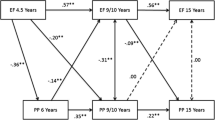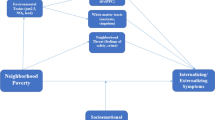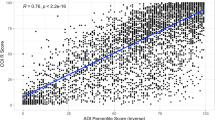Abstract
Purpose
To examine if cognitive ability moderates the effect of area (neighborhood) deprivation on young children’s problem behavior.
Methods
Data from the first two sweeps of the Millennium Cohort Study (MCS) in the UK were used. Children were clustered in small areas in nine strata in the UK and were aged 9 months at Sweep 1 and 3 years at Sweep 2. Neighborhood deprivation was measured with the Index of Multiple Deprivation at Sweep 1. Overall and specific problem behavior was measured with the Strengths and Difficulties Questionnaire at Sweep 2. To explore moderator specificity we used three indices of ability (verbal cognitive ability, non-verbal cognitive ability, and attainment of developmental milestones). Adjustment was made for child’s age and sex, and for Sweep 1 family adversity (number of adverse life events), family structure, mother’s social class and psychological distress, and family socio-economic disadvantage.
Results
We found both support for our main hypothesis, and evidence for specificity. Neighborhood deprivation was, even after adjustment for covariates, significantly associated with children’s peer problems. However, verbal and non-verbal cognitive ability moderated this association.
Conclusions
Neighborhood deprivation was related to peer problems even at preschool age. Although the effect of neighborhood deprivation on externalizing problems was mediated by family poverty and parental socio-economic position and although its effect on internalizing problems was mediated by parental mental health, its effect on difficulties with peers was independent of both parental and child characteristics. Cognitive ability moderated the effect of neighborhood deprivation on preschoolers’ peer relationships difficulties.
Similar content being viewed by others
References
McLoyd VC (1998) Socioeconomic disadvantage and child development. Am Psychol 53:185–204
Masten AS, Hubbard JJ, Gest SD, Tellegen A, Garmezy N, Ramirez M (1999) Competence in the context of adversity: pathways to resilience and maladaptation from childhood to late adolescence. Dev Psychopathol 11:143–169
Radke-Yarrow M, Brown E (1993) Resilience and vulnerability in children of multiple-risk families. Dev Psychopathol. 5:581–592
Werner E, Smith R (1992) Overcoming the odds: High-risk children from birth to adulthood. Cornell University Press, New York
Hauser ST (1999) Understanding resilient outcomes: adolescent lives across time and generations. J Res Adolesc 9:1–24
Werner E (1996) How kids become resilient: observations and cautions. Resiliency Action 1:18–28
Gottfredson LS, Deary IJ (2004) Intelligence predicts health and longevity, but why? Curr Dir Psychol Sci 13:1–4
Grant KE, Compas BE, Thurm AE, McMahon SD, Gipson PY, Campbell AJ, Krochock K, Westerholm RI (2006) Stressors and child and adolescent psychopathology: evidence of moderating and mediating effects. Clin Psychol Rev 26:257–283
Flouri E, Tzavidis N, Kallis C (2010) Adverse life events, area socioeconomic disadvantage, and psychopathology and resilience in young children: the importance of risk factors’ accumulation and protective factors’ specificity. Eur Child Adolesc Psychiatry 19:535–546
Haglund MEM, Nestadt PS, Cooper NS, Southwick SM, Charney DS (2007) Psychobiological mechanisms of resilience: relevance to prevention and treatment of stress-related psychopathology. Dev Psychopathol 19:889–920
Leventhal T, Brooks-Gunn J (2000) The neighborhoods they live in: the effects of neighborhood residence on child and adolescent outcomes. Psychol Bull 126:309–337
Banfield JF, Wyland CL, Macrae CN, Munte TF, Heatherton TF (1999) The cognitive neuroscience of self-regulation. In: Baumeister RF, Vohs KD (eds) Handbook of self-regulation: research, theory, and applications. Guildford, New York, pp 62–83
Shamosh NA, Gray JR (2008) Delay discounting and intelligence: a meta-analysis. Intell 36:289–305
Luthar SS, Cicchetti D, Becker B (2000) The construct of resilience: a critical evaluation and guidelines for future work. Child Dev 71:543–562
Barnes J, Belsky J, Frost M, Melhuish E. Neighborhood characteristics and mental health: the relevance for mothers of infants in deprived English neighborhoods. Soc Psychiatry Psychiatr Epidemiol (in press)
Malmberg LE, Flouri E (2011) The comparison and interdependence of maternal and paternal influences on young children’s behavior and resilience. J Clin Child Adolesc Psychol 40:434–444
Noble M, Wright G, Smith G, Dibben C (2006) Measuring multiple deprivation at the small area level. Environ Plan A 38:169–185
Tiet QQ, Bird HR, Davies M, Hoven C, Cohen P, Jensen PS, Goodman S (1998) Adverse life events and resilience. J Am Ac Child Adolesc Psychiatry 37:1191–1200
Brand AH, Johnson JH (1982) Note on reliability of the Life Events Checklist. Psychol Rep 50:1274
Coddington RD (1972) The significance of life events as etiologic factors in the diseases of children: I. A survey of professional workers. J Psychosom Res 16:7–18
Coddington RD (1972) The significance of life events as etiologic factors in the diseases of children: II. A study of a normal population. J Psychosom Res 16:205–213
Tiet QQ, Bird HR, Hoven CW, Moore R, Wu P, Wicks J, Jensen PS, Goodman S, Cohen P (2001) Relationship between specific adverse life events and psychiatric disorders. J Abnorm Child Psychol 29:153–164
Goodman R (1994) A modified version of the Rutter parent questionnaire including extra items on children’s strengths: a research note. J Child Psychol Psychiatry 35:1483–1494
Goodman R (1997) The strengths and difficulties questionnaire: a research note. J Child Psychol Psychiatry 38:581–586
Rutter M, Tizard J, Whitmore K (1970) Education, health, and behaviour. Longmans, London
Rodgers B, Pickles A, Power C, Collishaw S, Maughan B (1999) Validity of the Malaise Inventory in general population samples. Soc Psychiatry Psychiatr Epidemiol 34:333–341
Frankenburg WK, Dodds JB (1967) Denver developmental screening test. J Pediatr 71:181–191
Elliott CD (1983) British ability scales. Manual 1. NFER-Nelson, Windsor
Bracken BA (1998) Bracken Basic Concept Scale-Revised. The Psychological Corporation, Harcourt Brace and Company, San Antonio
Goldstein H (2003) Multilevel statistical models, 3rd edn. Arnold, London
Fergusson DM, Lynskey MT (1996) Adolescent resiliency to family adversity. J Child Psychol Psychiatry 37:281–292
Flouri E, Tzavidis N, Kallis C et al (2010) Area and family effects on the psychopathology of the Millennium Cohort Study children and their older siblings. J Child Psychol Psychiatry 51:152–161
Goodman E, Slap GB, Huang B (2003) The public health impact of socioeconomic status on adolescent depression and obesity. Am J Public Health 93:1844–1850
Reijneveld SA, Brugman E, Verhulst FC, Verloove-Vanhorick SP (2005) Area deprivation and child psychosocial problems: a national cross-sectional study among school-aged children. Soc Psychiatry Psychiatr Epidemiol 40:18–23
van der Linden J, Drukker M, Gunther N, Feron F, van Os J (2003) Children’s mental health service use, neighbourhood socioeconomic deprivation, and social capital. Soc Psychiatry Psychiatr Epidemiol 38:507–514
Acknowledgments
This study was funded by The British Academy
Author information
Authors and Affiliations
Corresponding author
Rights and permissions
About this article
Cite this article
Flouri, E., Mavroveli, S. & Tzavidis, N. Cognitive ability, neighborhood deprivation, and young children’s emotional and behavioral problems. Soc Psychiatry Psychiatr Epidemiol 47, 985–992 (2012). https://doi.org/10.1007/s00127-011-0406-4
Received:
Accepted:
Published:
Issue Date:
DOI: https://doi.org/10.1007/s00127-011-0406-4




